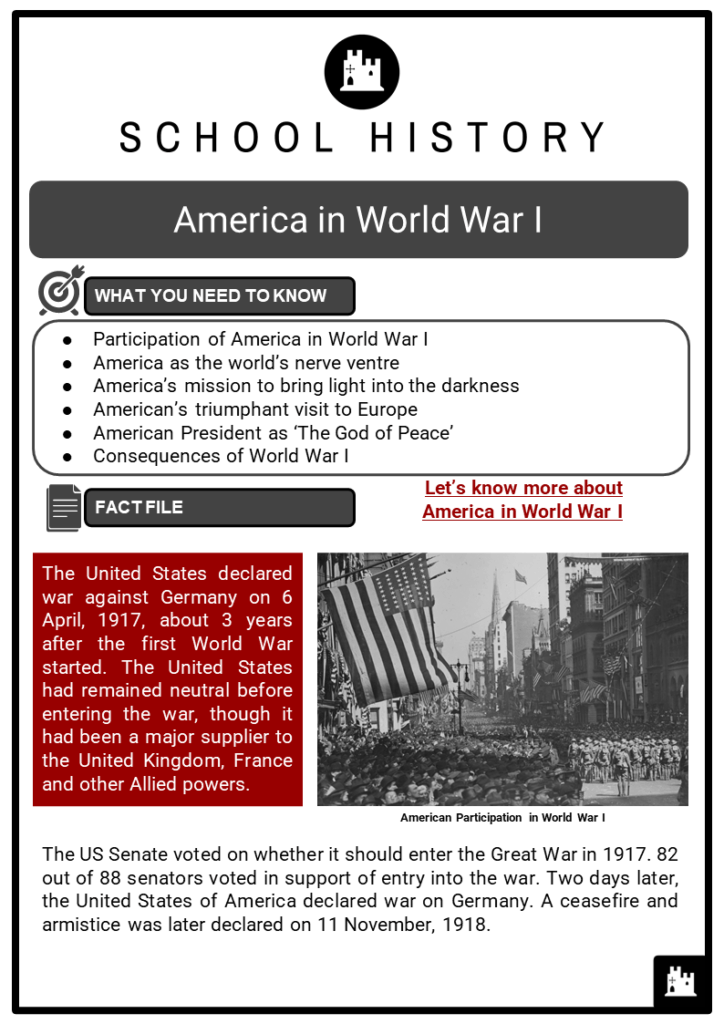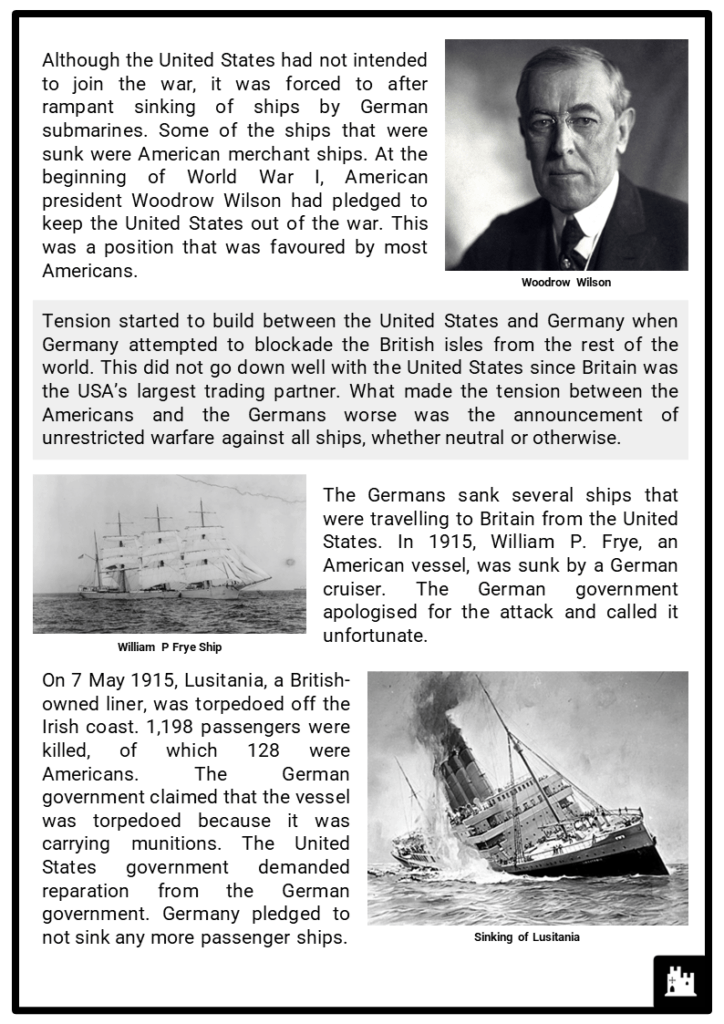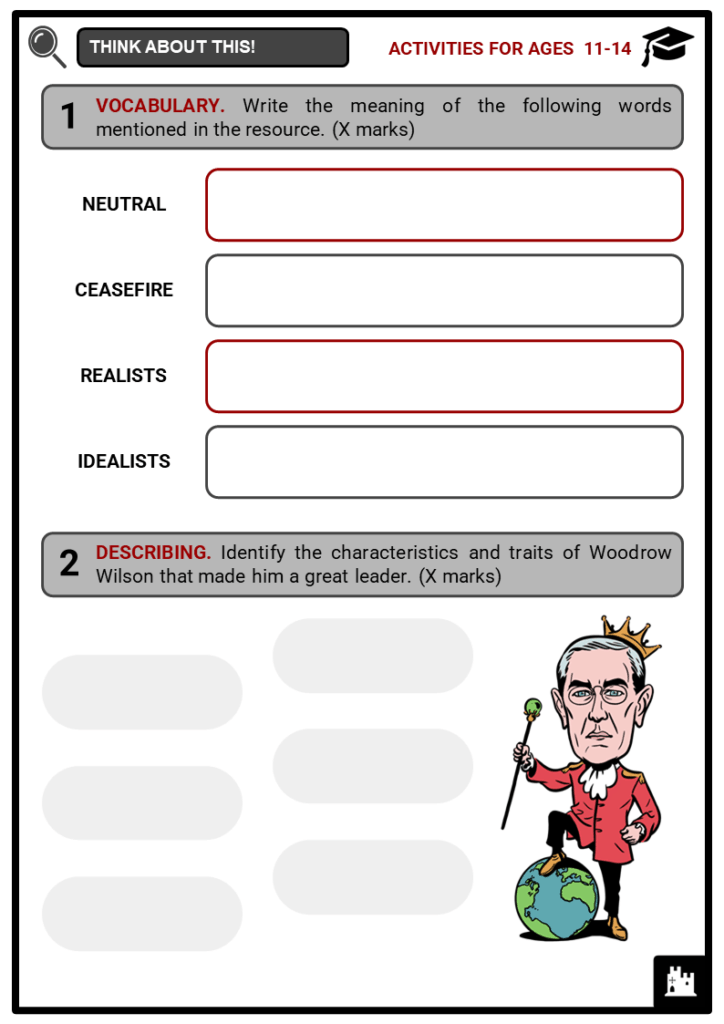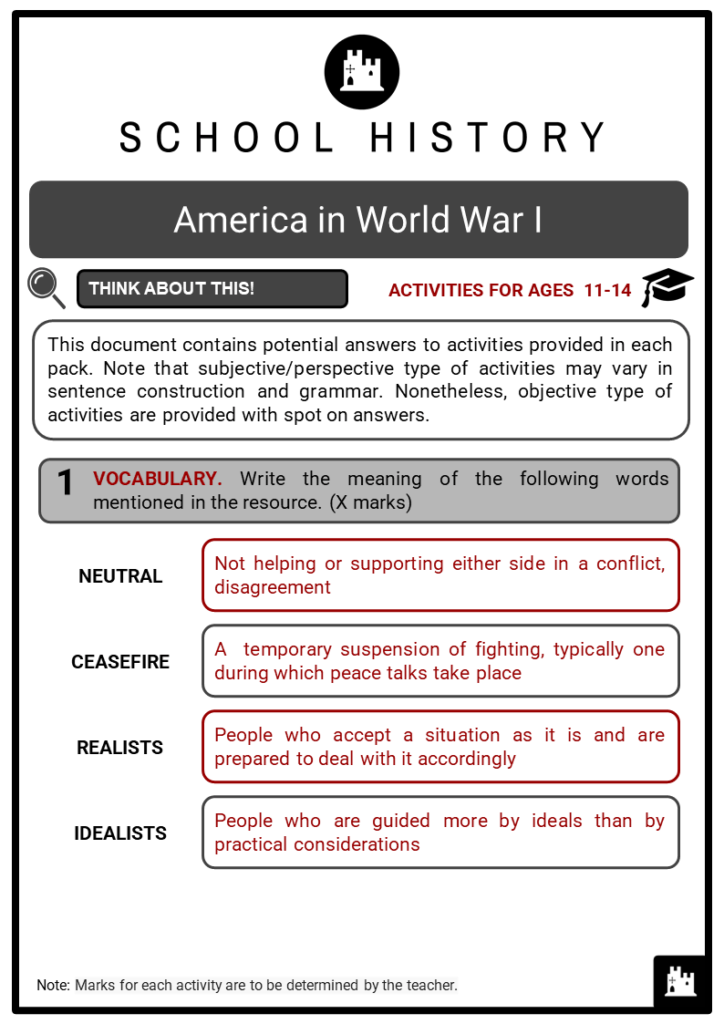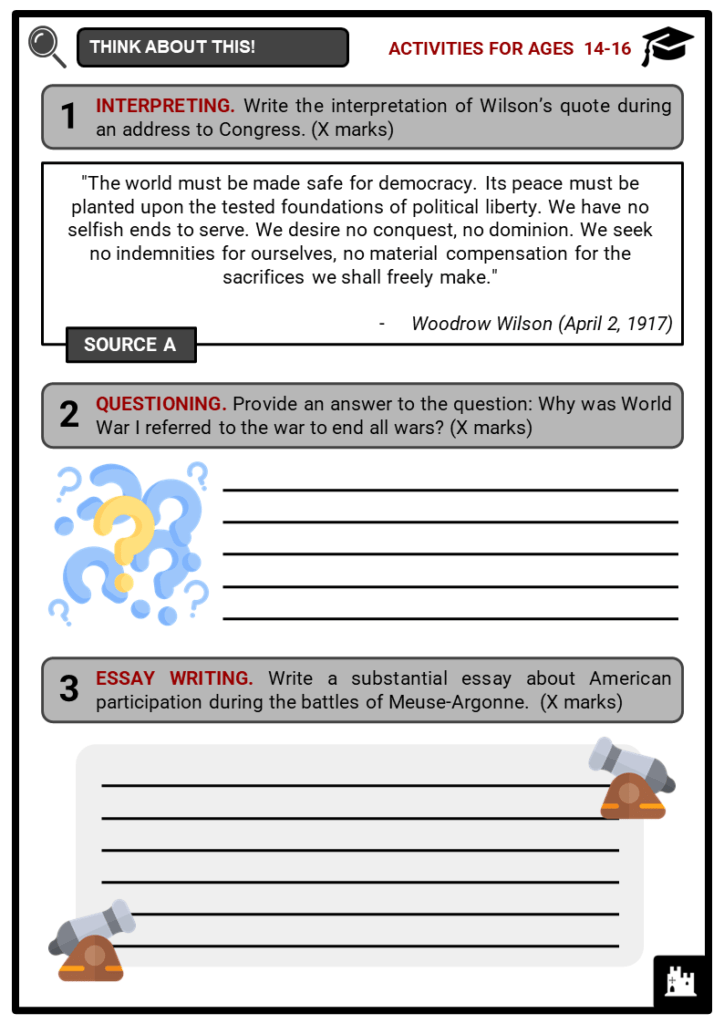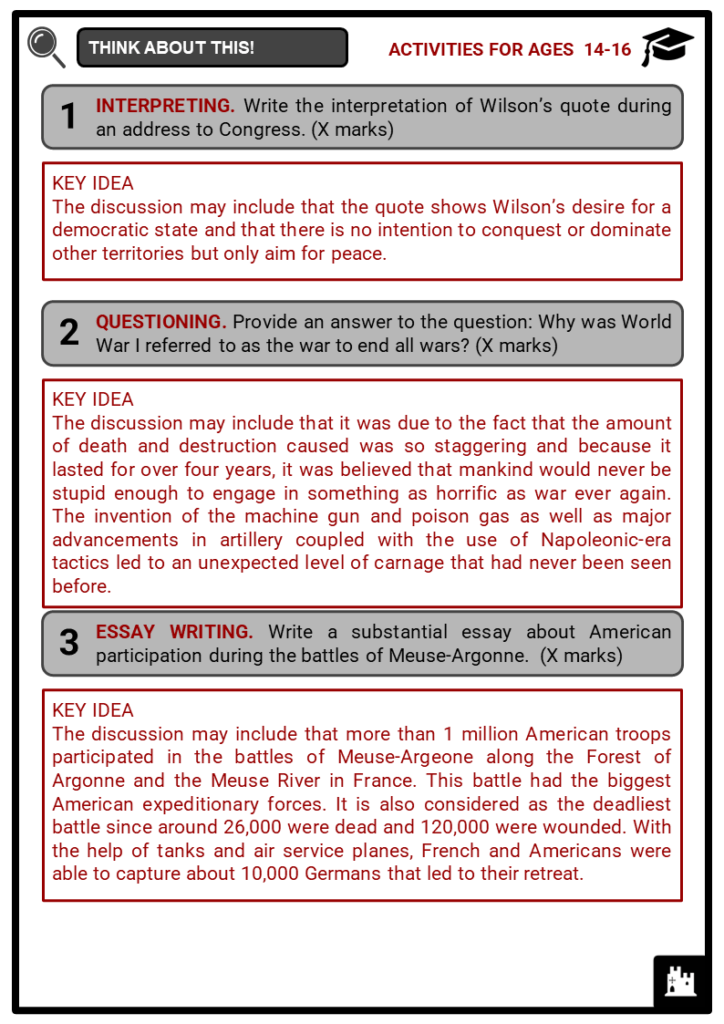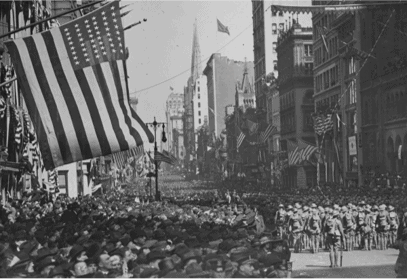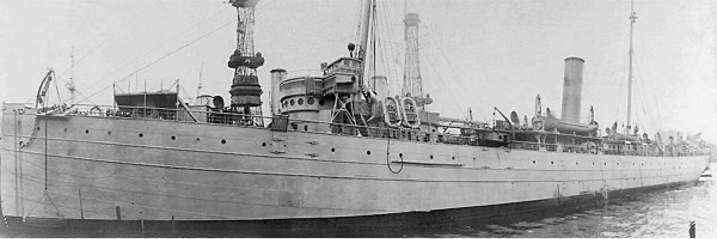Download America in World War I Worksheets
Do you want to save dozens of hours in time? Get your evenings and weekends back? Be able to teach America in World War I to your students?
Our worksheet bundle includes a fact file and printable worksheets and student activities. Perfect for both the classroom and homeschooling!
Table of Contents
Add a header to begin generating the table of contents
Summary
- Participation of America in World War I
- America as the world’s nerve centre
- America’s mission to bring light into the darkness
- American’s triumphant visit to Europe
- American President as ‘The God of Peace’
- Consequences of World War I
Key Facts And Information
Let’s know more about America in World War I
- The United States declared war against Germany on 6 April, 1917, about 3 years after the first World War started. The United States had remained neutral before entering the war, though it had been a major supplier to the United Kingdom, France and other Allied powers.
- The US Senate voted on whether it should enter the Great War in 1917. 82 out of 88 senators voted in support of entry into the war. Two days later, the United States of America declared war on Germany. A ceasefire and armistice was later declared on 11 November, 1918.
- Although the United States had not intended to join the war, it was forced to after rampant sinking of ships by German submarines. Some of the ships that were sunk were American merchant ships. At the beginning of World War I, American president Woodrow Wilson had pledged to keep the United States out of the war. This was a position that was favoured by most Americans.
- Tension started to build between the United States and Germany when Germany attempted to blockade the British isles from the rest of the world. This did not go down well with the United States since Britain was the USA’s largest trading partner. What made the tension between the Americans and the Germans worse was the announcement of unrestricted warfare against all ships, whether neutral or otherwise.
- The Germans sank several ships that were travelling to Britain from the United States. In 1915, William P. Frye, an American vessel, was sunk by a German cruiser. The German government apologised for the attack and called it unfortunate.
- On 7 May 1915, Lusitania, a British-owned liner, was torpedoed off the Irish coast. 1,198 passengers were killed, of which 128 were Americans. The German government claimed that the vessel was torpedoed because it was carrying munitions. The United States government demanded reparation from the German government. Germany pledged to not sink any more passenger ships.
- However, in November of the same year, the Germans sank an Italian liner with 272 people on board. Out of the 272 passengers, 27 of them were Americans. Public opinion in the United States began to turn against the Germans.
- In 1917, Germany announced that it was going to carry on with unrestricted warfare in the warzone waters. Three days after the announcement, the United States broke all diplomatic relations it had with Germany. Hours after that, Housatonic, an American liner, was sunk by the Germans.
- In March 1917, four more US merchant ships were sunk. On 2 April 1917, the United States’ president Woodrow Wilson appeared before Congress and urged it to declare war on Germany. Four days later, the United States officially entered the war.
- On 26 June 1917, the United States deployed 14,000 troops, which landed in France and began to train for combat. The entrance of America and its well-supplied troops into the war was a major turning point in the war. It played a significant role in the victory of the Allies.
- At the end of the war, on 11 November 1918, more than two million American troops had participated in the war. 50,000 American troops lost their lives in combat.
- The entry of the United States into the war marked the beginning of America’s path to becoming a world superpower. According to some historians, like Herfried Munkler, being a superpower was the main goal of some politicians in Washington.
The World’s Nerve Centre
- Although there were some politicians in Washington who saw America’s entry into the war as an opportunity to be a major power in world affairs, Woodrow Wilson, the only American president to get into politics after serving as the president of a university, had no ill motives. Woodrow Wilson was a down-to-earth president in many respects, including his stance on racism. Wilson’s goal was to save the world by ending the war once and for all.
- President Wilson successfully managed to draw the attention of Americans back to Europe. For the next 100 years, Europe would be at the centre of America’s foreign policy.
- Before and during World War I, the nerve centre of the world was Europe. Barely two years after the war began, millions of soldiers had lost their lives. The warring parties seemed incapable of bringing the war to an end. America had no other option but to intervene in the conflict.
Light Into The Darkness
- At the time of the First World War, American foreign policy was characterised by a fundamental conflict. The two sides, as far as American foreign policy was concerned, were the ‘realists’ and the ‘idealists’.
- The realists believed that America’s most important task was to ensure that there was balance between the interests of different countries in order to achieve a stable equilibrium.
- The other side of the foreign policymakers consisted of ‘idealists’. According to them, the United States had a duty to be a role model for other countries. The idealists believed that America’s mission was to bring light into the darkness of dependency and bondage.
A Triumphant Visit To Europe
- France and Britain implored American troops to fill in for the losses in their own ranks, however American generals insisted on keeping the American Army independent. American generals held back US troops until the early summer of 1918 when American troops began intervening on a large scale.
- The Americans began their offensive after the last German offensives had exhausted themselves. This contributed decisively in pushing back the Germans. When the new government in Germany, led by Chancellor Maximilian von Baden, offered a ceasefire to the American president, the Americans, feeling victorious, felt like they had a task to reorganise Europe. America believed they had saved the world, and they did not intend to let Europe forget it.
The God Of Peace
- When the war finally ended, American president Woodrow Wilson embarked on a European tour. He was the first US president to tour Europe. He was well-received; in fact, when he made a stop in Rome, he was called ‘The God of Peace’.
- Germany’s hopes also rested with the Americans. This is because the conditions of the ceasefire were to be centred on Wilson’s fourteen points. Wilson’s hopes were to achieve liberal principles within a worldwide framework. Everyone was to have the right to self-determination. There was also to be a restriction of arms on all of Europe. The most important point, above all, was the creation of a League of Nations in order to guarantee peace.
Consequences Of World War I
- World War I had a very big impact on the politics, culture and society of the United States of America. Suffragette activists managed to link the patriotic efforts that were made by women in the war with the right to vote. By 1920, barely two years after the war, Congress passed the Nineteenth Amendment, which allowed women the right to vote. However, there were also negative effects of the war. The war left US society in a hyper-vigilant mode, which led to outbreaks of violence against people who were viewed as disloyal to the United States. The people who suffered the most were German-Americans. Socialists and immigrants were also threatened and harassed.
- Civil liberties were also curtailed sharply with the Espionage Act being passed in 1917.
- It was a criminal offence for anyone to speak anti-war sentiments and criticism in public.
- People formed voluntary associations to help the government in identifying dissidents.
- This led to further violence as people took it upon themselves to patrol and round up dissidents and even punish them.
- World War I is also known as ‘the first modern war’. During World War I, several of the technologies that are today associated with military conflict — machine guns, tanks, aerial combat and radio communications — were introduced in large numbers.
- During World War I, the devastating consequences of chemical weapons like mustard gas and phosgene on soldiers and civilians spurred public and military opposition to their ongoing deployment. The Geneva Conventions, which were signed in 1925 and are still in place today, limit the use of chemical and biological weapons in battle.
- More than 9 million troops died in World War I, with another 21 million injured. Nearly ten million civilians died as a result of the war. Germany and France were the two countries most hit, with both sending 80 percent of their male populations between the ages of 15 and 49 to war.
- Millions of women also entered the workforce to replace males who went to war and those who never returned during World War I, causing immense societal upheaval. The first global war also aided in the spread of one of the world's deadliest pandemics, the 1918 Spanish flu outbreak, which killed an estimated 20 to 50 million people worldwide.
- On the political front, Americans sought to expand their role in world affairs. World War I also led to the rise of the ‘Lost Generation’. This was a generation that had become disillusioned with the ideals and values of American consumer culture and political democracy.
Image sources:

